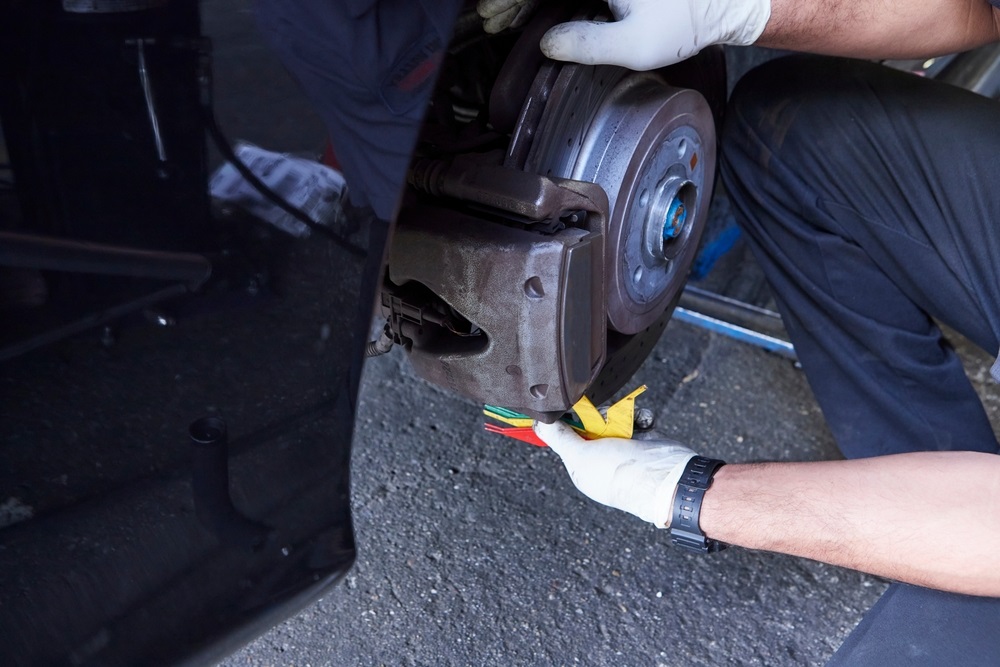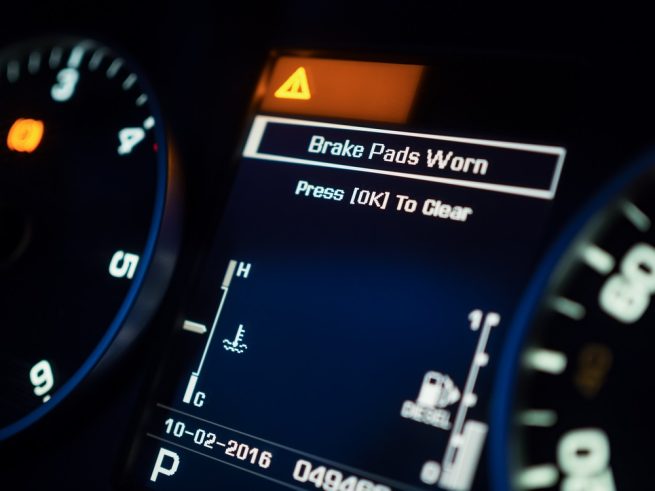Ignoring worn brake pads can cost you more than money—it can cost your safety. At EZ-Brakes, we’ve helped thousands of drivers avoid disasters by catching brake issues early. In this article, we’ll break down how worn out brake pads affect your car’s performance, the warning signs you should never ignore, and what happens if you wait too long. Spoiler: it’s not worth the risk.
1. Increased Stopping Distances Compromise Safety
Brake pads are your first line of defense on the road. When they wear out, your ability to stop quickly takes a major hit. As friction material thins, your brakes respond slower, increasing the time and distance it takes to come to a complete stop. This becomes especially dangerous in emergency situations—whether it’s a child running into the street or a sudden traffic jam on the freeway.
How this affects your driving:
- Longer stopping distance means you may not brake in time.
- More force needed on the brake pedal to slow down.
- Reduced control, especially in wet or icy conditions.
Front brake pads worn symptoms are often felt through a weak or delayed response when applying pressure to the brake pedal. If it feels like your vehicle “glides” before stopping, that’s a red flag.
Worn brake pads don’t just delay your reaction—they extend your risk zone. At EZ-Brakes, we emphasize preventative care because catching brake wear early is the difference between a smooth stop and a serious accident.
2. Worn Out Brake Pads Lead to Rotor and Caliper Damage
Brake pads are designed to protect the more expensive components in your braking system—namely, your rotors and calipers. When your pads are too thin, the metal backing plate presses directly against the rotors, causing metal-on-metal contact. This wears down your rotors, damages calipers, and can even lead to complete brake failure.
What worn brake pads and discs look like:
- Deep grooves carved into the rotor surface.
- Discolored rotors from excessive heat.
- Calipers seizing or locking up.
At this point, you’re no longer looking at a simple pad replacement—you’re facing a full brake system overhaul. And that comes with a much higher price tag.
At EZ-Brakes, we’ve seen drivers wait until they hear grinding noises before coming in. Often, that grinding is the sound of their rotors being ruined. A brake pad replacement is quick and affordable; replacing rotors and calipers can cost five times more. Don’t let it get that far.

3. Worn Brake Pads Make Noticeable Noises and Vibrations
What do worn brake pads sound like? If your brakes are talking to you—listen. Most brake pads come with built-in wear indicators that produce a squealing sound once the pads reach a critical level of wear. This wear indicator brake pads sound is your early warning system.
Other times, you’ll hear:
- Squeaking or squealing: Indicates mild to moderate wear.
- Grinding: Pads are completely worn; metal is contacting the rotor.
- Clunking or rattling: Pads may have become dislodged or calipers are affected.
Worn brake pads noise while driving (even when not braking) can include:
- Constant screeching when in motion.
- Random popping or knocking from wheel area.
- Loud grinding that gets worse with time.
Vibrations through the brake pedal or steering wheel are also symptoms of worn brake pads and rotors. It’s often caused by uneven pad wear or warped rotors. These vibrations not only affect comfort—they point to deeper problems in your vehicle’s braking system.
4. Poor Braking Can Lead to System-Wide Vehicle Damage
Driving with worn brake pads does more than harm your brakes—it affects your whole car. When your pads are failing, your vehicle works harder to stop, and that strain has ripple effects.
Here’s what else gets impacted:
- Fuel efficiency drops due to increased rolling resistance.
- Suspension and alignment suffer from uneven braking pressure.
- Tires wear unevenly due to instability during deceleration.
You might also notice that your anti-lock braking system (ABS) gets triggered more often. If you’re wondering, can worn brake pads cause ABS light to come on?—yes, they can. The system detects abnormalities in wheel rotation and responds to compensate, but it’s not a permanent fix. It’s a signal that something’s wrong.
The longer you delay, the more your repair bill grows. Worn brake pads vs new? New pads ensure smooth, responsive braking and optimal performance. Old pads endanger not only your wallet but every ride you take.

What Do Worn Brake Pads Look Like?
Wondering what to look for when inspecting your brakes?
Worn brake pads look:
- Thin (less than 1/4 inch of material)
- Uneven or slanted wear
- Scorched or glazed surface from overheating
At EZ-Brakes, we physically show our customers the difference between worn and healthy pads. We believe in transparency—and nothing speaks louder than visual proof.
HOW LONG CAN YOU DRIVE WITH WORN BRAKE PADS?
Driving with worn brake pads is always a gamble. Technically, you might still be able to drive for a few hundred miles, but every mile increases the risk of brake failure and costly damage.
- Most mechanics recommend replacing brake pads when they reach 3mm thickness or less.
- Continuing to drive can damage rotors, calipers, and suspension components.
- Delayed braking response becomes more noticeable and dangerous.
- We advise replacing pads as soon as symptoms appear—not when it’s already too late.
CAN WORN BRAKE PADS CAUSE SQUEAKING WHILE DRIVING?
Yes, and in fact, squeaking is one of the first worn brake pads symptoms. The noise often stems from the wear indicator, a small metal tab designed to alert you audibly when your brake pads are low.
- Worn brake pads sound like high-pitched squeals, especially when braking lightly.
- Sometimes, squeaking occurs even when you’re not braking—due to the wear indicator constantly rubbing.
- It can also be caused by debris or glazing from overheating the pads.
- Ignoring the worn brake pads sound while driving leads to grinding and rotor damage.
WHY IS ONLY ONE BRAKE PAD WORN?
Uneven wear—when only one brake pad is worn—often points to mechanical imbalance or part malfunction within your braking system.
- A stuck caliper can keep one pad in contact with the rotor, causing excessive wear.
- Misaligned brake hardware or corroded guide pins affect pad movement.
- Brake fluid imbalance or hydraulic issues may also apply uneven pressure.
- This situation leads to worn brake pads and discs on one side only, affecting handling and safety.
HOW CAN YOU TELL IF BRAKE PADS ARE WORN?
Recognizing signs of worn brake pads is essential for vehicle safety. Fortunately, your car gives plenty of warning—if you know what to look for.
- Noises like squeaking or grinding during braking.
- Increased stopping distance and slower response times.
- Vibrations in the steering wheel or brake pedal.
- Visual inspection: If the pad is less than 3mm thick, it’s time for a replacement.

FAQ About Worn Brake Pads
WHAT ARE COMMON SIGNS OF WORN BRAKE PADS?
Some of the most noticeable signs include squeaking or grinding noises, longer stopping distances, and vibrations during braking. If your car pulls to one side when braking or your brake pedal feels soft, it’s time for a check-up.
WHAT DO WORN BRAKE PADS SOUND LIKE?
The sounds vary depending on the level of wear. Initially, you’ll hear a high-pitched squeal. As they wear further, expect grinding noises—this is metal contacting metal. Don’t ignore it!
CAN WORN BRAKE PADS CAUSE THE ABS LIGHT TO COME ON?
Absolutely. When pads are overly worn, they can disrupt the balance of the braking system, prompting the ABS to engage or the light to illuminate. That light isn’t just a warning—it’s an alert for action.
IS DRIVING WITH WORN BRAKE PADS DANGEROUS?
Yes. The risks include extended stopping distances, total brake failure, and costly damage to other brake components. Your safety and your car’s health are both on the line.
HOW CAN I TELL IF MY FRONT BRAKE PADS ARE WORN?
Front brake pads tend to wear out faster due to the front-heavy weight distribution of most cars. Look for symptoms like nose-diving during stops, more brake dust on the front wheels, and high-pitched noises during forward braking.
The EZ-Brakes Promise: Safe Stops and Smart Savings
EZ-Brakes makes it easy to stay safe. Our certified technicians specialize in all things brakes—from quick pad replacements to full brake system diagnostics. We’re here to save you time, money, and unnecessary risk.When you come in for a brake check, we’ll show you:
- The exact condition of your brake pads.
- The wear level of your rotors and calipers.
- Customized maintenance options for your vehicle make and model.
Whether you’re hearing the first squeal or have waited until the grinding starts, EZ-Brakes is your go-to brake service provider. Don’t gamble with your brakes—book an appointment today.



